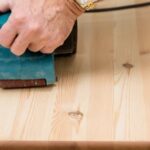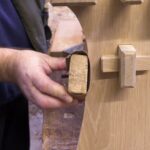Woodworking marking knives are essential tools for any woodworker looking to make accurate and precise markings on their projects. With a rich history in woodworking, marking knives have been used for centuries to scribe layout lines, mark mortises, and score wood fibers before cutting. Having the right marking knife is crucial for ensuring clean and accurate cuts, as well as improving the overall quality of woodworking projects.
These versatile tools come in various types, each with its own unique features and benefits. From bevel edge marking knives to spear-point marking knives, woodworkers have a range of options to choose from based on their specific needs and preferences. Understanding the pros and cons of each type can help woodworkers make an informed decision when selecting the right marking knife for their projects.
When it comes to choosing the right woodworking marking knife, several factors must be considered such as the blade material, handle design, and sharpness. Testing the quality and sharpness of a marking knife is also important in ensuring its effectiveness in woodworking projects. By understanding how to select the best tool for the job and properly maintain it, woodworkers can achieve more accurate results in their woodworking endeavors.
Types of Woodworking Marking Knives
Woodworking marking knives come in different types, each with its own unique features and benefits. When it comes to the types of woodworking marking knives, there are a few key options to consider, including bevel edge marking knives, spear-point marking knives, and combination marking knives.
Bevel Edge Marking Knives
Bevel edge marking knives are known for their precision and versatility. The beveled edge allows for easy maneuverability around tight corners and intricate details. These knives are often favored by woodworkers who prioritize accuracy and clean cuts in their projects. However, they can be more challenging to sharpen due to the angled blade.
Spear-Point Marking Knives
Spear-point marking knives have a sharp, pointed tip that is ideal for creating fine lines and detailed markings on wood. The pointed tip allows for easy penetration into the material without causing any tear-out or splintering. This type of knife is popular among woodworkers who work with delicate hardwoods or require intricate detailing in their projects.
Combination Marking Knives
Combination marking knives offer the best of both worlds by featuring a dual-edge design with both a bevel edge and a spear-point tip. This type of marking knife is versatile and can accommodate a wide range of woodworking tasks, from rough cutting to detailed carving. Woodworkers who need flexibility in their tools often opt for combination marking knives for their projects.
It’s important to carefully consider the specific needs of your woodworking projects when selecting the type of marking knife that will best suit your purposes. Each type has its strengths and weaknesses, so understanding how they align with your projects can help ensure you choose the right tool for the job.
Selecting the Right Woodworking Marking Knife
When it comes to woodworking, having the right tools is essential for achieving precision and accuracy in your projects. When selecting a woodworking marking knife, there are several factors to consider to ensure that you have the best tool for the job.
- Blade Material: The blade material of a marking knife is crucial as it determines its sharpness and durability. High-quality steel such as high-carbon or stainless steel is preferable, as it holds an edge well and can withstand the rigors of woodworking.
- Handle Design: The handle design of the marking knife plays a significant role in comfort and control during use. Ergonomically designed handles made of wood, metal, or composite materials provide a comfortable grip and allow for precise cutting without causing hand fatigue.
- Blade Type: There are different types of blade shapes for marking knives, including bevel edge, spear-point, and combination blades. Each type has its advantages and drawbacks, so it’s important to choose a blade shape that aligns with your specific woodworking needs. For example, a bevel edge blade excels at marking straight lines on flat surfaces, while a spear-point blade is ideal for scoring into wood grain.
How to Test the Quality and Sharpness of a Marking Knife
Once you’ve narrowed down your options for woodworking marking knives based on the factors mentioned above, it’s essential to test the quality and sharpness of the knife before making a purchase. A simple yet effective way to test the sharpness of a marking knife is by lightly drawing it across end-grain wood.
If the knife easily creates a fine score line without tearing wood fibers or creating excess resistance, then it is sharp enough for precise woodworking tasks.
Additionally, examining the overall construction quality of the marking knife will give you insight into its durability and longevity. Check for any signs of rust or corrosion on the blade, ensure that the handle is securely attached to the blade with no wobbling or loose parts, and assess whether the knife feels well-balanced in your hand.
By thoroughly evaluating these aspects before making a purchase, you can select a high-quality woodworking marking knife that will enhance your woodworking projects.
By taking into account these considerations when choosing a woodworking marking knife and testing its quality before purchasing one ensures that you’ll have a reliable tool that enhances your accuracy and precision in all your woodworking endeavors.
Proper Techniques for Using a Woodworking Marking Knife
Using a woodworking marking knife is essential for achieving precise and accurate results in your woodworking projects. To ensure that you get the most out of this tool, it’s important to use proper techniques when working with a marking knife. Here is a step-by-step guide on how to use a marking knife effectively:
- First, make sure that your woodworking marking knife is sharp. A dull blade can cause tear-out and inaccuracies in your markings. You can test the sharpness of your marking knife by gently running it across a piece of scrap wood. If it leaves a clean, shallow cut without tearing the wood fibers, then it’s sharp enough for use.
- When marking your wood, hold the blade of the marking knife against the edge of a square or straight edge to ensure straight and accurate lines. Use light pressure to score the wood along the cutting gauge line.
- Once you have made your marks with the marking knife, use these shallow cuts as guides for other tools such as chisels or saws.
It’s also important to remember to always cut away from yourself when using a woodworking marking knife to prevent accidents and injuries.
| Proper Techniques | Woodworking Marking Knife |
|---|---|
| Ensure that your marking knife is sharp before use | Sharpness is crucial for precise markings |
| Use a square or straight edge as a guide for accurate lines | Provides straight and accurate markings |
| Cut away from yourself when using the knife | Prevents accidents and injuries |
Benefits of Using a Woodworking Marking Knife
Woodworking marking knives are an essential tool for any woodworker, offering unparalleled precision and accuracy when marking wood for crafting. Unlike pencil or other marking tools, a woodworking marking knife creates a crisp and clean line that is easy to follow with a chisel or saw.
This precision is invaluable for joinery work and other intricate woodworking tasks. Additionally, the use of a woodworking marking knife reduces the risk of tear-out compared to other marking methods, resulting in cleaner and more professional-looking finished projects.
One of the key benefits of using a woodworking marking knife is the improved accuracy it provides. Because the knife creates a physical indentation in the wood surface, it acts as a guide for subsequent cuts and ensures that the workpiece is accurately marked for shaping or joining. This level of precision is particularly important for fine woodworking and can make all the difference in achieving seamless joints and flawless craftsmanship.
Furthermore, using a woodworking marking knife also allows for better control over grain direction when cutting or chiseling. By scoring along the wood fibers, woodworkers can prevent tear-out and achieve cleaner cuts, particularly on hardwoods and figured woods which tend to be more prone to splintering. The result is higher-quality joinery with tight-fitting components that enhance the overall integrity and strength of the project.
Lastly, woodworking marking knives also provide versatility in terms of mark thickness, as they can easily create both fine lines for detailed work and deeper grooves for heavier-duty joinery tasks. This adaptability makes them suitable for a wide range of woodworking projects, from delicate marquetry to robust mortise-and-tenon joints.
| Benefits | Details |
|---|---|
| Precision | Creates crisp and clean lines for accurate cutting or chiseling. |
| Grain Direction Control | Prevents tear-out by providing controlled cuts along wood fibers. |
| Versatility | Allows for different mark thicknesses suitable for various woodworking projects. |
Common Mistakes to Avoid When Using a Woodworking Marking Knife
When using a woodworking marking knife, there are several common mistakes that beginners and even experienced woodworkers can make. Avoiding these mistakes is crucial to ensure accuracy and precision in your woodworking projects. Here are some common mistakes to watch out for and how to troubleshoot them:
- Using too much force: One common mistake when using a marking knife is applying too much pressure when scoring the wood. This can cause the blade to wander off course and create inaccurate markings. To avoid this, use a light touch and let the sharpness of the blade do the work for you.
- Incorrect positioning: Another mistake is not positioning the marking knife correctly before making the cut. Ensure that the blade is held perpendicular to the surface of the wood to create a straight and clean score line.
- Not maintaining sharpness: A dull blade can lead to tearing or splintering of the wood fibers, resulting in messy markings. It’s important to regularly sharpen and maintain the blade of your marking knife to ensure clean and precise cuts.
If you find yourself making these mistakes, there are ways to troubleshoot and fix them. For instance, if you’ve applied too much force and veered off course, you can carefully sand down any excess material with fine-grit sandpaper.
If your positioning was off, use a chisel or hand plane to remove any stray wood fibers and redefine your mark. Finally, if your marking knife blade is dull, invest in a good sharpening stone or honing guide to restore its sharpness.
Overall, being mindful of these common mistakes will help you achieve better results when using a woodworking marking knife for your projects.
Finally, an important aspect of using a woodworking marking knife is ensuring its longevity by taking care of it properly through regular maintenance and sharpening. By avoiding these common pitfalls and maintaining your marking knife well, you’ll be able to enjoy accurate markings and precise cuts in your woodworking endeavors for years to come.
DIY Woodworking Marking Knife Projects
Are you looking to add a personal touch to your woodworking projects? Consider making your own woodworking marking knife. This DIY project allows you to customize a marking knife that fits your specific needs and preferences. Below are some instructions for creating your own custom marking knife:
- Choose the right material: Select a high-quality steel blade for the best cutting performance. You can also repurpose an old utility knife blade for this project.
- Create a handle: Use wood, acrylic, or any other suitable material to craft a comfortable and ergonomic handle for your marking knife.
- Assemble the components: Carefully attach the blade to the handle, making sure it is secure and aligned properly.
Personalizing and customizing your own marking knife not only gives you a tool that is tailored to your specific needs but also adds a unique touch to your woodworking endeavors. Whether you prefer a classic wooden handle or a more modern material, such as acrylic, you have the freedom to create a marking knife that reflects your style and personality.
There are numerous creative ideas for personalizing and customizing a marking knife, such as adding decorative engravings, inlays, or colorful accents. By making your own marking knife, you can take pride in using a tool that you crafted with care and attention to detail. Plus, these DIY projects can be both enjoyable and fulfilling for woodworking enthusiasts of all skill levels.
Top Woodworking Marking Knives on the Market
In conclusion, the woodworking marking knife is an essential tool for any serious woodworker. With a rich history and a wide range of uses, it is clear that having the right marking knife can make a significant difference in the accuracy and quality of woodworking projects.
When selecting a woodworking marking knife, there are various factors to consider, including blade material, handle design, and sharpness. Proper techniques for using a marking knife are crucial for achieving precision and avoiding common mistakes.
Using a woodworking marking knife offers several benefits over other marking tools such as pencils or marking gauges. It improves the accuracy and quality of woodworking projects and allows for more precise layout work. However, it is important to be aware of common mistakes when using a marking knife and how to troubleshoot and fix them when they occur.
For those looking to personalize their tools or take on a DIY project, making your own custom woodworking marking knife can be a rewarding endeavor. There are numerous creative ideas for personalizing and customizing a marking knife to fit your specific needs and preferences.
Lastly, with many options available on the market, it’s crucial to explore reviews and recommendations for the top woodworking marking knives that best suit different skill levels and budgets. Whether purchasing or creating one yourself, having the right woodworking marking knife is indispensable for any woodworker striving for precision and excellence in their craft.
Frequently Asked Questions
What Is a Marking Knife Used for in Woodworking?
A marking knife is used in woodworking to accurately mark the layout lines on wood. It creates a precise and clean line, which is crucial for making accurate cuts and joints.
Do I Need a Marking Knife?
Whether or not you need a marking knife depends on the type of woodworking projects you’re doing. If you require precise markings for joinery or need to transfer measurements accurately, then a marking knife would be beneficial.
How Do I Choose a Marking Knife?
When choosing a marking knife, consider the blade material, handle design, and overall feel in your hand. Look for a durable blade that holds an edge well and a comfortable handle that allows for precise control and accuracy in your markings. Additionally, consider the type of woodworking you do as different projects may require different types of marking knives.

Hi everyone! I’m a woodworker and blogger, and this is my woodworking blog. In my blog, I share tips and tricks for woodworkers of all skill levels, as well as project ideas that you can try yourself.





